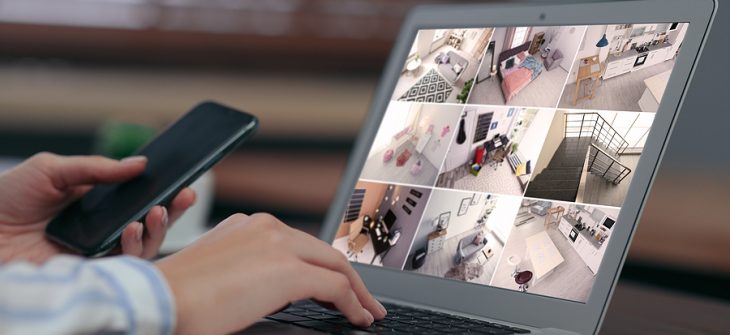Whether you’re upgrading your current system or exploring home security options for the first time, cameras are a great place to start!
Security cameras give you eyes on your entire property, providing peace of mind no matter where you are. Most importantly, they strengthen your family’s safety by discouraging intruders and enabling identification of trespassers. If a burglary does occur, security camera footage can also help you recover stolen items.
For advice on choosing between the multitude of options on the market today, keep reading:
Indoor or Outdoor?
If you don’t have any security cameras yet, they are a crucial part of enhancing your outdoor security. It stands to reason that if an intruder enters your home at all, they will be seen first outside. These cameras can actually alert you to a break-in before it happens.
Indoor cameras are great for guarding specific locations with a high concentration of valuable items. However, it’s best to keep them out of bedrooms and bathrooms to preserve your privacy. For example, if you keep expensive jewelry upstairs, it may be wise to place a camera on the second floor landing so that anyone who climbs the stairs can be caught.
Location, Location, Location
When deciding what type of security cameras to put up around your home, first consider where they will go.
The front and back doors and first floor windows are the most common points of entry for break-ins. If you don’t already have cameras in these locations, you will want to start here. Placing a security camera next to your front door will help you guard the most popular entry point – nearly 34% of burglars enter through the front door!
Your cameras should be visible but out of reach. Placing one below nine feet off the ground leaves it more vulnerable to damage by intruders. However, if your camera is too far out of sight, it will not be as effective at discouraging break-in attempts in the first place. Knowing what surface you will mount your camera on can also help you choose a type to buy.
Lastly, think about the area that you want to capture with your camera. Is it a doorstep, garage, or perhaps the entire front yard? The fewer cameras you have, the wider you’ll want the frame to be. Once you decide, you can better determine whether to invest in a wide-angle or rotating lens to monitor larger areas, or a focused lens with smaller range.
Other Factors to Consider
After you have chosen locations for your security cameras, thinking about a few other factors can help narrow your search.
Weatherproofing: An outdoor camera will need to be able to withstand the elements – including any inclement weather that could occur in your area. Some cameras made for dual indoor and outdoor use are weatherproofed as well, but always make sure to check.
Power Source: Do you want your cameras to be battery-powered or hard-wired? You can avoid the need to recharge your cameras by choosing a hard-wired option, but battery-powered models allow for more flexibility in terms of placement and portability. A doorbell camera is one hard-wired option that we always recommend.
Cloud Storage: Footage of a break-in is worthless if you can’t see it! Make sure you know where video is stored. Most manufacturers store their cameras’ video in a cloud-based system connected through an app, and many offer a variety of plans for access. Ideally, you’ll want to choose a camera with a plan that allows you to access all of your footage without paying extra.
Privacy: Look into any manufacturer’s privacy measures and reviews before buying. While footage of your home should belong only to you, sometimes weaker security protocols can lead content being leaked or easily hacked, as we’ve seen with many DIY camera options. Two-factor authentication and strong encryption can minimize this risk, but make sure to be aware and set up strong passwords to prevent this from happening.
Selecting the Right Features
Once you have chosen locations, the fun part begins. There are a wide variety of options to choose from – security cameras have come a long way since the first models entered the market! The below features can take your purchase from good to great:
- Resolution – Security cameras usually range from 480p to 1080p, and more detail makes for easier identification and facial recognition.
- Audio – Not all cameras record this along with video, but two-way audio can allow you to communicate with whoever is at the door or sound sirens to ward off intruders.
- App Support– A good, modern security system will be easy to sync with all of your devices and allow for access to video and alerts using an app on your phone.
- Motion Detection – This feature can alert you whenever a specified area sees some type of movement. Advanced systems will be able to distinguish between normal disturbances, like animals, and more sinister ones.
- Night Vision – Over half of burglaries happen in the evening or night time, so this feature should be a priority if you don’t have lights on around your camera 24/7.
- Low-light Performance – Night vision may not activate until darkness fully hits, meaning that video quality can be lower around dusk or dawn.
Ask the Experts at SafeTouch About Security Cameras Today!
Now that you are prepared to choose a new security camera – or two or three – for your home, contact the experts at SafeTouch to assist you with installation. Our experienced professionals can provide support in your decision-making process and ensure correct setup for optimal functionality. Contact SafeTouch Security today for more information on how we can help with your home security needs!

